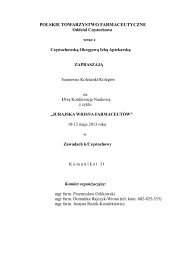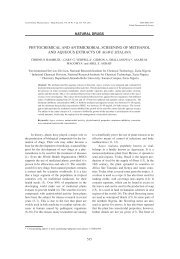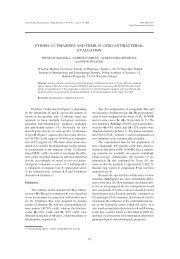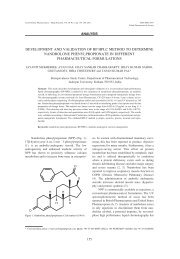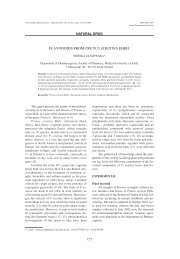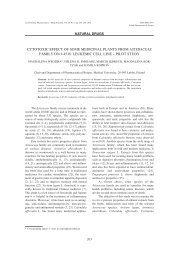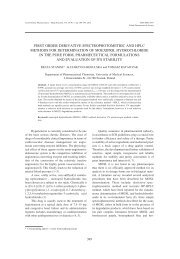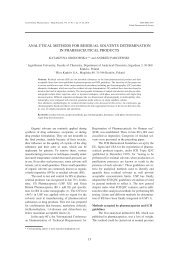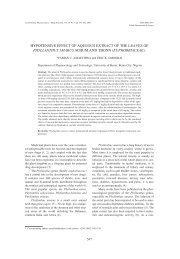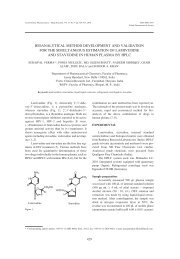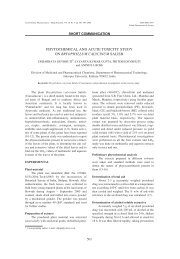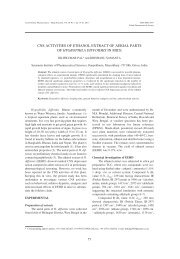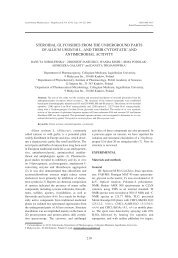identification and analysis of drugs in the solid state by 13c cpmas nmr
identification and analysis of drugs in the solid state by 13c cpmas nmr
identification and analysis of drugs in the solid state by 13c cpmas nmr
You also want an ePaper? Increase the reach of your titles
YUMPU automatically turns print PDFs into web optimized ePapers that Google loves.
300 KATARZYNA PARADOWSKA et al.<br />
Figure 5. 13 C CPMAS NMR spectra <strong>of</strong> cortisone hemisucc<strong>in</strong>ate: a) st<strong>and</strong>ard <strong>and</strong> b) with depolar dephas<strong>in</strong>g.<br />
isotope dilution-mass spectrometry are time-consum<strong>in</strong>g<br />
<strong>and</strong> expensive (10). For <strong>the</strong> future NMR<br />
study <strong>of</strong> <strong>the</strong> metabolism <strong>in</strong> humans isotopically<br />
labeled compounds are necessary. The syn<strong>the</strong>sis <strong>of</strong><br />
multi-labeled cortisol <strong>and</strong> cortisone with 13 C <strong>and</strong> 2 H<br />
was described (11), <strong>and</strong> <strong>the</strong>ir 13 C <strong>and</strong> 1 H NMR spectra<br />
were fully assigned.<br />
Cortisone <strong>in</strong> <strong>the</strong> form <strong>of</strong> <strong>the</strong> acetate ester exists<br />
<strong>in</strong> <strong>solid</strong> phase <strong>in</strong> several polymorphic forms, also as<br />
solvated crystals (pseudopolymorphs). Six crystall<strong>in</strong>e<br />
forms were dist<strong>in</strong>ctly found <strong>by</strong> <strong>the</strong> <strong>analysis</strong> <strong>of</strong><br />
<strong>solid</strong> <strong>state</strong> 13 C NMR spectra <strong>of</strong> n<strong>in</strong>e various samples<br />
(12). Crystal structures are known for three forms<br />
<strong>and</strong>, <strong>the</strong>refore some correlation between NMR <strong>and</strong><br />
XRD results could be made. Chemical shift differences<br />
between <strong>solid</strong> forms appear <strong>in</strong> <strong>the</strong> side cha<strong>in</strong><br />
<strong>and</strong> <strong>the</strong> conformations <strong>of</strong> r<strong>in</strong>g A. Chemical shift <strong>of</strong><br />
C3=O is larger for <strong>solid</strong> sample than for solution<br />
spectra, <strong>the</strong> effect is related with hydrogen bond<strong>in</strong>g.<br />
Separate CH <strong>and</strong> CH 2 resonances <strong>in</strong> 13 C MAS spectra<br />
can be obta<strong>in</strong>ed <strong>by</strong> polarization <strong>in</strong>version follow<strong>in</strong>g<br />
cross polarization (a CPPI procedure). This procedure<br />
has been applied to polymorphism situations,<br />
as illustrated <strong>by</strong> Harris (13) for form I <strong>of</strong> cortisone<br />
acetate. However, <strong>the</strong>re is no <strong>solid</strong>-<strong>state</strong> NMR data<br />
on hydrocortisone hemisucc<strong>in</strong>ate.<br />
13<br />
C CPMAS NMR spectra were recorded for<br />
<strong>solid</strong> hydrocortisone 21-hemisucc<strong>in</strong>ate, <strong>and</strong> st<strong>and</strong>ard<br />
spectrum is shown <strong>in</strong> Figure 5a. Chemical<br />
shifts are collected <strong>in</strong> Table 2. The spectra were<br />
assigned on <strong>the</strong> basis <strong>of</strong> liquid-<strong>state</strong> chemical shifts<br />
<strong>and</strong> dipolar dephas<strong>in</strong>g (DD) experiment The <strong>solid</strong><br />
<strong>state</strong> peaks have chemical shifts almost <strong>the</strong> same as<br />
<strong>the</strong>ir liquid <strong>state</strong> counterparts. The differences <strong>of</strong><br />
3.0-3.5 ppm were observed for carbonyl carbons.<br />
Deshield<strong>in</strong>g <strong>of</strong> 3.5 ppm occurs for carbonyl carbon<br />
atom (a) <strong>of</strong> ester l<strong>in</strong>kage. These results <strong>in</strong>dicate that<br />
steroid structure is relatively rigid <strong>in</strong> solution, without<br />
much conformational freedom <strong>and</strong> result<strong>in</strong>g<br />
average <strong>of</strong> chemical shifts. The signals <strong>of</strong> methylene<br />
carbon atoms: 1, 2, 6, 7, 8 <strong>and</strong> 15, as well as<br />
those <strong>of</strong> succ<strong>in</strong>ate (b, c) give rise to a broad peak at<br />
30-33 ppm. The resonances <strong>of</strong> quaternary carbon<br />
atoms C10 <strong>and</strong> C13 can be easily dist<strong>in</strong>guished <strong>in</strong><br />
<strong>the</strong> spectrum recorded with DD pulse sequence<br />
(Figure 5b). All resonances appear to be broader<br />
<strong>the</strong>n usually observed for crystall<strong>in</strong>e steroid-type<br />
compounds, <strong>in</strong>dicat<strong>in</strong>g that <strong>the</strong> studied sample is<br />
amorphous.<br />
CONCLUSIONS<br />
13<br />
C CPMAS NMR allows for fast <strong>identification</strong><br />
<strong>of</strong> <strong>solid</strong> organic material, without any preparation<br />
procedures. The advantage <strong>of</strong> <strong>solid</strong>-<strong>state</strong> technique<br />
is also its non-destructive character; <strong>the</strong> sample<br />
removed from rotor can be fur<strong>the</strong>r used for <strong>analysis</strong><br />
<strong>by</strong> solution NMR or chromatography. It is evident at<br />
first sight that <strong>the</strong> 13 C MAS spectra <strong>of</strong> hydrocortisone<br />
<strong>and</strong> succ<strong>in</strong>ylchol<strong>in</strong>e are quite different,<br />
although both compounds have carbonyl <strong>and</strong> methylene<br />
groups.



